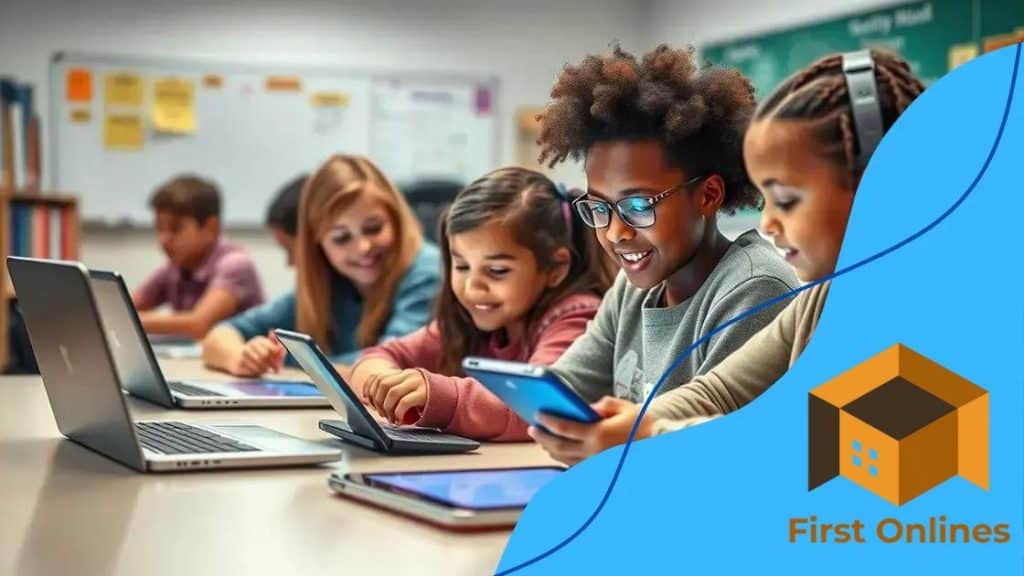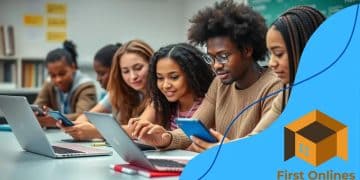How digital classrooms are reshaping K–12 education

Anúncios
How digital classrooms are reshaping K–12 education by enhancing engagement, promoting personalized learning, and facilitating global collaboration, while addressing challenges like the digital divide and the need for teacher training.
How digital classrooms are reshaping K–12 education is a topic that’s exciting and complex. Have you ever wondered how technology changes the way kids learn? Here, we’ll dive into the impacts of these modern classrooms.
Anúncios
Understanding digital classrooms
Understanding digital classrooms can seem challenging, but it’s crucial to know how they influence education. These classrooms utilize technology to transform traditional learning methods into engaging experiences.
What are digital classrooms?
Digital classrooms combine various digital tools and techniques to enhance learning. They allow students and teachers to connect through the internet, making learning more interactive. This is not just about using computers; it’s about creating a rich environment for learning.
Key elements of digital classrooms
- Accessibility: Students can access materials from anywhere.
- Engagement: Interactive tools keep students motivated.
- Personalization: Tailored learning experiences meet individual needs.
With these elements, digital classrooms provide a flexible learning atmosphere. They support innovative teaching methods, such as flipped classrooms, where students learn content at home and engage in activities at school.
Anúncios
Technology also plays a role in breaking barriers. Students can collaborate on projects using cloud storage, which encourages teamwork and idea sharing. This approach prepares them for real-world workplaces that often rely on technology.
Benefits for teachers
Teachers benefit significantly from digital classrooms. They can easily track student progress through various digital tools. Moreover, reporting and assessment become streamlined, allowing educators to focus more on teaching rather than paperwork.
Challenges of digital classrooms
Despite their advantages, digital classrooms face challenges. Not all students have equal access to technology, leading to a digital divide. Schools must address these gaps to provide equal opportunities for all learners.
Another challenge is maintaining student attention in a world full of distractions. Teachers must find creative ways to keep students engaged while using technology.
Technology’s role in education

Technology’s role in education has become increasingly important in recent years. From enhancing classroom learning to providing resources beyond school, it’s transforming how students engage with information.
Interactive learning tools
One significant aspect of technology in education is interactive learning tools. Programs and apps help students grasp complex topics through visual aids and engaging activities. This kind of technology supports active learning, where students participate rather than just passively listen.
Access to online resources
Online resources are another game changer. With just a few clicks, students can access a wealth of information. They can explore educational videos, articles, and other materials that complement their studies. This increases knowledge retention and supports diverse learning styles.
- Educational videos: Platforms like YouTube offer endless content on various subjects.
- Online libraries: Students can access books and articles from their homes.
- Tutoring services: Virtual tutors are available for additional help.
In addition, technology allows for personalized learning experiences. Students can work at their own pace, retracing steps as needed. This leads to greater understanding and mastery of subjects, promoting lifelong learning.
Collaboration and communication
Beyond individual learning, technology enhances collaboration among students. Tools such as discussion boards and group chat platforms enable communication and teamwork on projects. This not only fosters social skills but also prepares students for future workplaces where collaboration is key.
Furthermore, teachers benefit from technology as well. They can share resources easily and communicate with students and parents more efficiently. By embracing these tools, educators create a more dynamic and engaging learning environment for everyone.
Benefits for students and teachers
The benefits for students and teachers in a digital classroom are numerous and impactful. These technologies not only enhance the learning experience but also improve teaching methods significantly.
Enhanced engagement
Digital classrooms lead to greater engagement among students. Interactive tools capture their attention, making learning fun and exciting. This active participation encourages students to explore topics more deeply, boosting motivation.
Improved collaboration
Collaboration is another key benefit. Students can work together on projects easily, regardless of their physical location. Tools like shared documents and video conferencing allow for seamless communication and teamwork. This helps develop essential social skills that are valuable in the modern world.
- Real-time feedback: Teachers can provide immediate feedback on assignments.
- Diverse resources: Students have access to various learning materials that cater to their interests.
- Flexible learning: Students can work at their own pace, which helps them understand concepts better.
Additionally, digital classrooms offer personalized learning experiences. Teachers can tailor lessons to meet the needs of each student. This ensures that no child is left behind, fostering a supportive learning environment.
Ease of assessment
For teachers, the digital classroom simplifies assessments. Online quizzes and assignments can be graded quickly, allowing educators to focus more on teaching. This efficiency also leads to improvement in student performance because teachers can identify areas where students struggle.
Moreover, teachers can track progress over time. This ability to monitor growth helps in creating customized learning plans that align with each student’s unique learning style. The result is a more effective educational experience for everyone involved.
Challenges faced in implementation

Challenges faced in implementation of digital classrooms can hinder progress. While technology opens doors, it also brings obstacles that educators and schools need to address. Awareness of these challenges can help smooth the transition to digital learning.
Digital divide
One significant issue is the digital divide. Not all students have equal access to the internet or devices. This inequality can lead to differences in learning opportunities, affecting students’ overall performance.
Training for teachers
Another challenge is the need for proper training for teachers. Many educators may feel overwhelmed by new technologies. Thus, schools must provide ongoing support to help them adapt and utilize digital tools effectively.
- Professional development: Regular workshops can train teachers on using new technologies.
- Peer support: Encouraging collaboration among educators can foster sharing of successful practices.
- Resource allocation: Schools should ensure they allocate enough resources for teacher training.
Moreover, adapting the curriculum to integrate technology poses its own set of challenges. Educators need to redesign lesson plans to make full use of digital tools. This process can be time-consuming and requires collaboration among staff to ensure a cohesive approach.
Resistance to change
Resistance to change among educators can further complicate implementation. Some teachers may prefer traditional methods and be hesitant to embrace new ways of teaching. Open discussions about the benefits of technology can help ease this transition and encourage buy-in from all staff members.
Finally, the maintenance of technology itself presents challenges. Schools must keep devices updated and secure. This ongoing effort can strain budgets and human resources, yet it is essential for a successful digital learning environment.
Future of K–12 education with tech
The future of K–12 education with tech looks bright. Emerging technologies promise to reshape how students learn and educators teach. Innovations like virtual reality (VR), augmented reality (AR), and artificial intelligence (AI) are set to enhance educational experiences significantly.
Innovative Learning Environments
One exciting development is the creation of innovative learning environments. These spaces use technologies to create immersive experiences. Students can explore complex scientific concepts through simulations, enhancing their understanding and retention. This hands-on approach makes learning more engaging and practical.
Personalized Learning
Technology will also enable more personalized learning experiences. AI-powered platforms can analyze individual learning patterns and adapt content to suit each student’s needs. This ensures that all students receive the support they require to grow academically.
- Adaptive learning tools: These tools change based on the student’s pace and understanding.
- Data-driven insights: Teachers can gain insights into student progress and adapt lessons accordingly.
- Tailored resources: Students can access materials that fit their unique interests and challenges.
Moreover, tech tools will facilitate anytime, anywhere learning. Students will have access to resources outside traditional classroom hours, promoting lifelong learning habits.
Enhanced Collaboration
The future of K–12 education emphasizes enhanced collaboration. Digital platforms will connect students from different backgrounds and geographies. They can work together on projects, fostering teamwork and cultural understanding.
In addition, teachers will have opportunities for continuous professional development through online courses. This support will allow educators to stay current with new teaching strategies and tools, benefiting their classrooms.
FAQ – Frequently Asked Questions about Technology in K–12 Education
How does technology enhance student engagement?
Technology uses interactive tools and resources that make learning more enjoyable, capturing students’ attention and motivating them to participate actively.
What are the benefits of personalized learning?
Personalized learning adapts to each student’s unique needs, allowing them to learn at their own pace and style, which can lead to better academic outcomes.
What challenges do schools face when implementing technology?
Schools often face issues like the digital divide, lack of teacher training, and resistance to change, which can complicate the integration of digital tools in classrooms.
What innovations can we expect in the future of K–12 education?
The future may include advanced technologies such as virtual reality, artificial intelligence, and enhanced online resources that create immersive and engaging learning environments.





